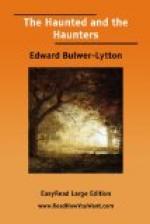Sir John made up his story about the jackanape as he liked himsell; and some believe till this day there was no more in the matter than the filching nature of the brute. Indeed, ye’ll no hinder some to threap, that it was nane o’ the Auld Enemy that Dougal and my gudesire saw in the Laird’s room, but only that wanchancy creature, the Major, capering on the coffin; and that, as to the blawing on the Laird’s whistle that was heard after he was dead, the filthy brute could do that as weel as the Laird himsell, if no better. But Heaven kens the truth, whilk first came out by the minister’s wife, after Sir John and her ain gudeman were baith in the moulds. And then my gudesire, wha was failed in his limbs, but not in his judgment or memory—at least nothing to speak of—was obliged to tell the real narrative to his freends, for the credit of his good name. He might else have been charged for a warlock.
FOOTNOTES:
[Footnote 6: A precipitous side of a mountain in Moffatdale.]
[Footnote 7: The caution and moderation of King William III., and his principles of unlimited toleration, deprived the Cameronians of the opportunity they ardently desired, to retaliate the injuries which they had received during the reign of prelacy, and purify the land, as they called it, from the pollution of blood. They esteemed the Revolution, therefore, only a half measure, which neither comprehended the rebuilding the Kirk in its full splendour, nor the revenge of the death of the Saints on their persecutors.]
[Footnote 8: A celebrated wizard, executed at Edinburgh for sorcery and other crimes.]
[Footnote 9: The reader is referred for particulars to Pitscottie’s History of Scotland.]
II
GHOST STORIES FROM LOCAL RECORDS, FOLK LORE AND LEGEND
XVIII
GLAMIS CASTLE
Local Records
“The Castle of Glamis, a venerable and majestic pile of buildings,” says an old Scots Gazetteer, “is situate about one mile north from the village, on the flat grounds at the confluence of the Glamis Burn and the Dean. There is a print of it given by Slezer in Charles II.’s reign—by which it appears to have been anciently much more extensive, being a large quadrangular mass of buildings, having two courts in front, with a tower in each, and gateway through below them; and on the northern side was the principal tower, which now constitutes the central portion of the present castle upwards of 100 feet in height. The building received the addition of a tower, in one of its angles, for a spiral staircase from bottom to top, with conical roofs. The wings were added, at the same time, by Patrick Earl of Strathmore, who repaired and modernised the structure, under the directions of Inigo Jones. One of the wings has been renovated within the last forty years, and other additions made, but not in harmony with Earl Patrick’s repairs.




